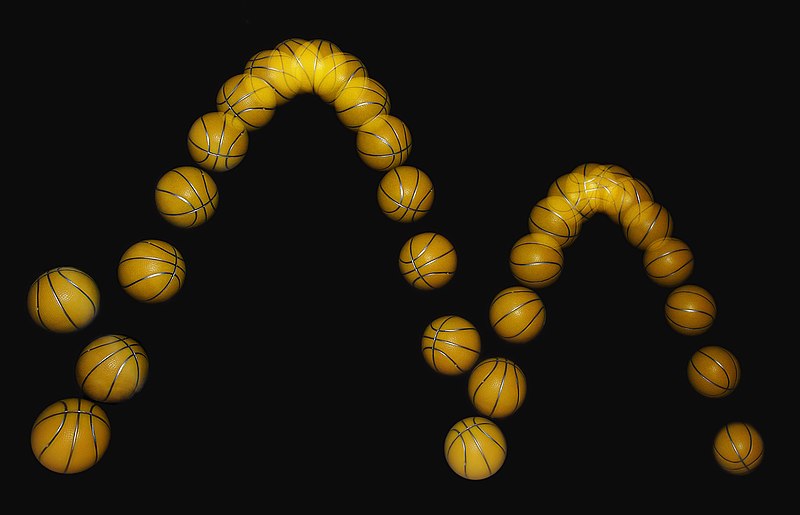파일:Bouncing ball strobe edit.jpg

미리 보기 크기: 800 × 515 픽셀 다른 해상도: 320 × 206 픽셀 | 640 × 412 픽셀 | 1,024 × 659 픽셀 | 1,280 × 824 픽셀 | 1,800 × 1,159 픽셀
원본 파일 (1,800 × 1,159 픽셀, 파일 크기: 293 KB, MIME 종류: image/jpeg)
파일 역사
날짜/시간 링크를 클릭하면 해당 시간의 파일을 볼 수 있습니다.
| 날짜/시간 | 섬네일 | 크기 | 사용자 | 설명 | |
|---|---|---|---|---|---|
| 현재 | 2007년 10월 9일 (화) 02:27 |  | 1,800 × 1,159 (293 KB) | Richard Bartz | {{Information |Description=A bouncing ball captured with a stroboscopic flash at 25 images per second. Note that the ball becomes significantly non-spherical after each bounce, especially after the first. That, along with spin and air-resistance, causes |
이 파일을 사용하는 문서
다음 문서 2개가 이 파일을 사용하고 있습니다:
이 파일을 사용하고 있는 모든 위키의 문서 목록
다음 위키에서 이 파일을 사용하고 있습니다:
- am.wikipedia.org에서 이 파일을 사용하고 있는 문서 목록
- ar.wikipedia.org에서 이 파일을 사용하고 있는 문서 목록
- az.wikipedia.org에서 이 파일을 사용하고 있는 문서 목록
- ba.wikipedia.org에서 이 파일을 사용하고 있는 문서 목록
- be.wikipedia.org에서 이 파일을 사용하고 있는 문서 목록
- bjn.wikipedia.org에서 이 파일을 사용하고 있는 문서 목록
- bn.wikipedia.org에서 이 파일을 사용하고 있는 문서 목록
- ca.wikipedia.org에서 이 파일을 사용하고 있는 문서 목록
- ca.wikibooks.org에서 이 파일을 사용하고 있는 문서 목록
- ckb.wikipedia.org에서 이 파일을 사용하고 있는 문서 목록
- cs.wikipedia.org에서 이 파일을 사용하고 있는 문서 목록
- cv.wikipedia.org에서 이 파일을 사용하고 있는 문서 목록
- da.wikipedia.org에서 이 파일을 사용하고 있는 문서 목록
- de.wikipedia.org에서 이 파일을 사용하고 있는 문서 목록
- de.wiktionary.org에서 이 파일을 사용하고 있는 문서 목록
- en.wikipedia.org에서 이 파일을 사용하고 있는 문서 목록
- Parabola
- Newton's laws of motion
- Inelastic collision
- Past
- Stroboscope
- Portal:Science
- Coefficient of restitution
- User talk:MichaelMaggs/Archive/2
- Wikipedia:Featured pictures thumbs/08
- Wikipedia:Featured picture candidates/October-2007
- User talk:MER-C/archives/19
- Wikipedia:Featured picture candidates/Projectile motion
- Wikipedia:Wikipedia Signpost/2007-10-22/Features and admins
- Portal:Physics/2008 Selected pictures
- Wikipedia:Featured pictures/Sciences/Others
- User talk:MER-C/archives/21
- Wikipedia:Picture of the day/February 2008
이 파일의 더 많은 사용 내역을 봅니다.

